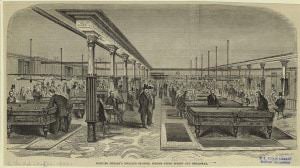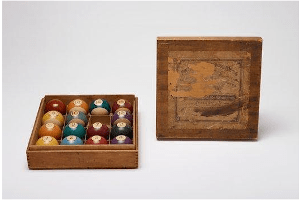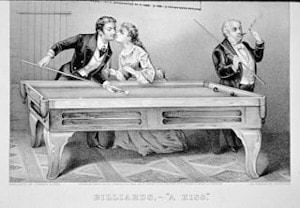A Bit of Billiards History
A pool table is the perfect way to spend time with family and friends when it's cold and gray outside. But did you know that pool tables and billiards tables have some interesting moments in their past -- including some that involve elephants and explosions?
Let's dive into some fascinating billiards history.
 Back in the mid-late 19th century, the game of billiards was enjoying a particularly popular time. Billiard "saloons" could be found in the many new cities burgeoning across the land. Billiards became so popular, in fact, that a concern arose about the potential scarcity of ivory. Good billiard balls were manufactured exclusively from Asian elephants, top grade ivory being the traditional and ideal material to make them. It offered the correct density, the proper roll, and the desired rebound properties required to achieve a good shot. Panic in the billiard parlors arose; not so much for the decreasing elephant population, but for the concern that billiard balls were going to become scarce as well.
Back in the mid-late 19th century, the game of billiards was enjoying a particularly popular time. Billiard "saloons" could be found in the many new cities burgeoning across the land. Billiards became so popular, in fact, that a concern arose about the potential scarcity of ivory. Good billiard balls were manufactured exclusively from Asian elephants, top grade ivory being the traditional and ideal material to make them. It offered the correct density, the proper roll, and the desired rebound properties required to achieve a good shot. Panic in the billiard parlors arose; not so much for the decreasing elephant population, but for the concern that billiard balls were going to become scarce as well.
There was a company, Phelan and Collender, who was a major supplier of billiard supplies at this time. Michael Phelan, one of the co-owners, was not only a businessman, he was also a billiard enthusiast. He wrote a book called The Game of Billiards, and was also famous for playing pool ten hours straight in front of a large crowd of fans. He was particularly concerned about the expense and scarcity of that desired ivory, ostensibly because it was his not only his livelihood it was also his passion. The company Phelan and Collender offered a $10,000 reward (in 1863, mind you) for anyone who could figure out an appropriate replacement for ivory.
 In 1865, John Wesley Hyatt patented his compound billiard ball, which featured a wood fiber core, covered with ivory dust and shellac. Billiard players, and Phelan and Collender were not impressed. Hyatt, who was not a chemist, but was seriously determined to figure this billiard ball problem out, continued to search for something that would be a good substitute for ivory. After a lab mishap which pointed him in the right direction, Hyatt ended up with a ball crafted from cellulose nitrate, aka, guncotton, and camphor oil. It could be mixed with color, and molded into nearly any shape. Hyatt patented the new substance, and trademarked it with the name "celluloid."
In 1865, John Wesley Hyatt patented his compound billiard ball, which featured a wood fiber core, covered with ivory dust and shellac. Billiard players, and Phelan and Collender were not impressed. Hyatt, who was not a chemist, but was seriously determined to figure this billiard ball problem out, continued to search for something that would be a good substitute for ivory. After a lab mishap which pointed him in the right direction, Hyatt ended up with a ball crafted from cellulose nitrate, aka, guncotton, and camphor oil. It could be mixed with color, and molded into nearly any shape. Hyatt patented the new substance, and trademarked it with the name "celluloid."
If you are of a certain age, or are a film enthusiast, you might recall being in a theater, when suddenly the show you were watching dissolved into a melting, crackling glob reflected on the screen. That film was made of celluloid. So Hyatt's billiard balls had a few undeniable flaws. If a billiard ball made of celluloid got too close to a flame, it would ignite. And, occasionally, when two balls made contact, there was an explosion. Sometimes this would result in every man in the room drawing a gun. It was the days of the wild west, after all.
 Interestingly, and maybe not surprisingly, people didn't really seem to mind the exploding billiard balls. However, they weren't really practical. Celluloid fell out of favor, as the creation of less explosive plastics were developed. Billiard balls were eventually made of the resin product we are all familiar with today.
Interestingly, and maybe not surprisingly, people didn't really seem to mind the exploding billiard balls. However, they weren't really practical. Celluloid fell out of favor, as the creation of less explosive plastics were developed. Billiard balls were eventually made of the resin product we are all familiar with today.
Did the game of billiards save the elephants? Well, unfortunately the populations continue to decline and unscrupulous people continue to kill them for ivory, even though it is against the law. However, the game of billiards was, in some measure, responsible for the invention of the plastics we are all dependent upon today.
Modern-day pool tables not only have non-exploding balls, they come in a variety of sizes and styles that will fit in any environment. Check out our guide to finding the right pool table for your home.Join the Discussion:
Comments
No posts found
